静电吸附驱动模块及其应用
IF 4.1
3区 工程技术
Q2 ENGINEERING, ELECTRICAL & ELECTRONIC
引用次数: 0
摘要
本文提出了一种静电吸附致动模块,它利用静电吸附膜的累积和叠加形成弹簧构型。每个致动模块由 20 层静电吸附膜组成,这些静电吸附膜由沉积在聚酰亚胺(PI)薄膜上的铜层和粘合剂 PI 薄膜覆盖层构成。通过将刚度为 58 N/m 的弹簧串联起来并预先拉伸 2 mm,模块的最大近似输出位移和力分别约为 1.10 mm 和 0.108 N。为了演示静电吸附致动模块的应用,设计了一个双模块拮抗致动器、一个爬行机器人、一个力反馈按钮和一个抓手。结果表明,由静电吸附薄膜积聚而成的致动模块可实现轻型微型致动器设计,拮抗致动器可实现约 0.8 毫米的双向往复运动。爬行机器人可在光滑表面上以约 0.34 mm/s 的速度爬行,力反馈按钮可根据不同电压下的位移变化实现力反馈功能。该抓手可成功抓取约 1 克的轻型物体。这项工作为未来仿人机器人的轻型人工肌肉设计奠定了基础。本文章由计算机程序翻译,如有差异,请以英文原文为准。
An electrostatic adsorption actuation module and its application
In this paper, an electrostatic adsorption actuation module is proposed, which uses the accumulation and superposition of electrostatic adsorption film to form a spring configuration. Each actuation module consists of 20 electrostatic adsorption films, which are composed of copper layers deposited on polyimide (PI) films and adhesive PI film covering layers. The maximum approximate output displacement and force of the module are about 1.10 mm and 0.108 N, respectively, by connecting springs with stiffness of 58 N/m in series and pre-stretching them by 2 mm. In order to demonstrate the application of an electrostatic adsorption actuation module, a dual-module antagonistic actuator, a crawling robot, a force feedback button and a gripper are designed. The results indicate that the actuation module accumulated by electrostatic adsorption film can achieve a lightweight microactuator design, and the antagonistic actuator can achieve a bidirectional reciprocating motion of about 0.8 mm. The crawling robot can crawl at a speed of about 0.34 mm/s on a smooth surface, and the force feedback button can achieve a force feedback function based on displacement changes under different voltages. The gripper can successfully grasp about 1 g of light objects. This work lays a foundation for the lightweight artificial muscle design of humanoid robots in the future.
求助全文
通过发布文献求助,成功后即可免费获取论文全文。
去求助
来源期刊

Sensors and Actuators A-physical
工程技术-工程:电子与电气
CiteScore
8.10
自引率
6.50%
发文量
630
审稿时长
49 days
期刊介绍:
Sensors and Actuators A: Physical brings together multidisciplinary interests in one journal entirely devoted to disseminating information on all aspects of research and development of solid-state devices for transducing physical signals. Sensors and Actuators A: Physical regularly publishes original papers, letters to the Editors and from time to time invited review articles within the following device areas:
• Fundamentals and Physics, such as: classification of effects, physical effects, measurement theory, modelling of sensors, measurement standards, measurement errors, units and constants, time and frequency measurement. Modeling papers should bring new modeling techniques to the field and be supported by experimental results.
• Materials and their Processing, such as: piezoelectric materials, polymers, metal oxides, III-V and II-VI semiconductors, thick and thin films, optical glass fibres, amorphous, polycrystalline and monocrystalline silicon.
• Optoelectronic sensors, such as: photovoltaic diodes, photoconductors, photodiodes, phototransistors, positron-sensitive photodetectors, optoisolators, photodiode arrays, charge-coupled devices, light-emitting diodes, injection lasers and liquid-crystal displays.
• Mechanical sensors, such as: metallic, thin-film and semiconductor strain gauges, diffused silicon pressure sensors, silicon accelerometers, solid-state displacement transducers, piezo junction devices, piezoelectric field-effect transducers (PiFETs), tunnel-diode strain sensors, surface acoustic wave devices, silicon micromechanical switches, solid-state flow meters and electronic flow controllers.
Etc...
 求助内容:
求助内容: 应助结果提醒方式:
应助结果提醒方式:


